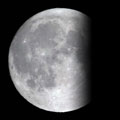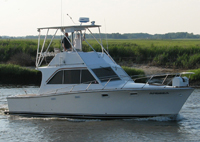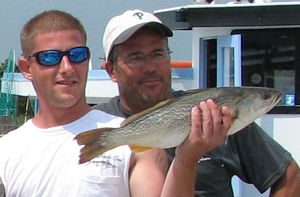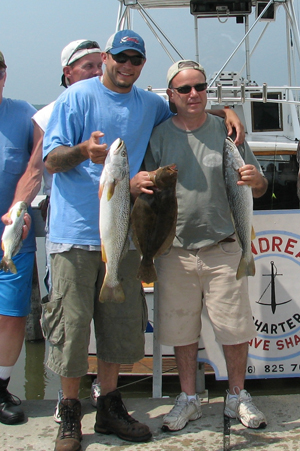| When the Going Gets Tough The Tough Adapt! Summertime Weakfishing on Delaware Bay By Mark Marquez II |
||
|
Maybe summertime was warmer Or snows were higher. Or maybe weakfish were more abundant in Delaware Bay. The temps and snows could be questionable, like something older people only think. But the part about weakfish can Anglers bailed weakfish on the bay more than a decade ago. Some boaters will remember trip after trip, wondering how so many anglers could haul in so many fish. They didn’t know those were the golden years, when Fortescue, a port on the bay, rightly claimed itself the Weakfish Capitol of the World. The bay’s weakies are less He still specializes in the bay’s weakfishing, and some anglers might be surprised, but his charters load up on the trout at times. Nobody, not even the government, knows why the population changed. The government has said overfishing is not the cause of the decline in weakfish. Old timers sometimes say weakies are “cyclical,” growing abundant for a period, becoming scarce another, for unknown reasons, and that they’ve seen the fish come and go. However, the ways to catch them now are known. But anglers have to adapt. |
|
In the past when massive schools of weakies jammed the bay, the first ones pushed in from late April to May in large waves, and anglers hammered schools in open waters while casting bucktails with big, rubber worms. As always, the first were spawning fish--larger, mature ones, often called tiderunners. They came in, did their business, and soon left. A little later in the season the main population of smaller weaks invaded, staying a longer time through summer. Tiderunners still come first, a little later than in the past, and the main population still comes next, but considerably later than before.
Nowadays, when the tiderunners come, they’re a lot less numerous, and not found in open waters. Dave tackles the early group in two places: in deep waters either in the ebb behind the lighthouses or at the concrete debris at the Delaware reefs in the northern bay; or tight to shore near the grass banks. The days of open-water tiderunners are gone, though they could return. But none of the fish holds in the open between those two places at this time. His anglers these days usually toss soft plastic lures to the spawners at the lighthouses and reefs until shedder crabs become available, and then he switches to shedders, a favorite weakfish forage in the bay. But this story is about summertime weakfishing, so details about catching the tiderunners are for another. When the main body of smaller weaks arrives in August, like the tiderunners, they are also more structure-oriented than in the past, and that is an important point. They are very specifically located in smaller schools, and anglers have to find them. The summer weaks can gather at the same structure as the early season fish: the lighthouses, reefs and grassy shoreline. But they’ll also hold at more subtle structure, unlike the tiderunners. This means places like a 1-foot drop-off on open grounds, or even a flat that can be structure. The slight changes in bottom that always make the waters around the number 1 buoy a fish-holding locale are an example. Some boaters drift, and they can catch, but Dave anchors, and so do most weakfishers. Anchoring’s always worked better for him, producing more catches than the one or two weaks that might get picked per drift. Because the fish are more finicky than in the past, bait is crucial, and this is another key point.
What do the fish feed on during summer? Shedder crabs, or molting blueclaws, and grass shrimp. They don’t feed on squid, for example. If you see schools of squid swarming, you better check your coordinates. They are not typically found in the bay. Still, many anglers fish squid or other baits for weakfish, and they will catch a few, but not as many. When not fishing along the shore grass, use shedder crabs for bait. When fishing near the grass, use grass shrimp. That’s the hatch. Dave fishes a small piece of shedder on a single-hooked fish-finder rig. If bait-stealers are around, such as juvenile fish, a small piece of squid is impaled on the hook after the shedder, to help keep the crab hooked. Some anglers gob enough shedder, squid, minnows, bloodworms or whatever else on the hook to choke a horse, he said. That doesn’t work. The weaks are smaller and more finicky. He uses a small hook, like a 1/0, on an 18- to 24-inch, fluorocarbon leader on the fish finder, with a bead on either side of the sinker-slide, and just enough weight to feel bottom. He also prefers bucktail and a little flash on the hook. Anglers can buy hooks dressed like that, but Dave ties his own, right on board the boat.
Different colors work at different times, and one never knows what the preference will be. Dave used to say any color works, so long as it’s green. But a variety of bucktail colors work at different times, including bubble gum and blue. Probably 30 different colors of bucktail are kept on the Andrea. The smaller hook helps give the bait motion, instead of a larger one that would bog down the bait. Motion matters. His anglers are taught to impart action to the rig. The bay is murky, so motion helps weakfish see the bait, and scavenger fish like sharks and skates pounce on stationary baits, so motion helps avoid them. The anglers cast out the rig, let it sink to the bottom, lift up 6 or 8 inches, let it sink back down, lift up, repeat, until the rig is back at the boat, and then they do it all over again. When shedders start to become scarce in September, don’t worry. Match the hatch. What’s in the bay at that time? Small croakers and bluefish. Dave then primarily dunks small strips of those fish. Nothing could be better than croaker, and a strip of the hardhead can illicit vicious attacks, he said. Summer weakfish are smallest in the beginning of August, and anglers will have to cull through to land keepers. But keepers can be found. The trout later in August are larger, maybe 14- to 20-inchers. In September they’re a little bigger. When Dave was a kid, weakfish were scarce in the bay, and the bay’s anglers fished for kingfish and croakers instead. When weaks were recently abundant, croakers were scarce in the bay. Croakers lately were abundant, and kingfish this year were more numerous than past years. Maybe the cycle has flip-flopped, and maybe it’ll flip-flop back. Or maybe not. These fish are a mystery to people. But how to catch them isn’t. |
||



 While the main run could take place from late June to August in years before, it now filters in around August through September.
While the main run could take place from late June to August in years before, it now filters in around August through September. Matching the hatch is the only way to go.
Matching the hatch is the only way to go. The bucktail and flash get attached by snelling the leader on the hook.
The bucktail and flash get attached by snelling the leader on the hook.